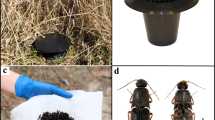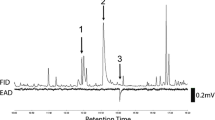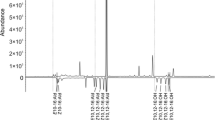Abstract
This study offers experimental evidence for the existence of three pheromone races of the northern genitalic form of Phyllophaga anxia: one race in which females produce and males respond mainly to l-valine methyl ester, a second producing and responding to l-isoleucine methyl ester, and a third producing and responding to an intermediate range of blends of the two compounds. At Franklinville, NY, pheromone gland contents of females were analyzed using coupled gas chromatography–electroantennogram detection. Two types of females were found, one that produced greater than 99% l-valine methyl ester and another that produced greater than 99% l-isoleucine methyl ester. Capture–mark–release–recapture field tests with males at Franklinville established that most males were recaptured in traps baited with the same blends with which they were originally captured. The populations characterized at Franklinville, NY, have also been found at numerous locations from eastern Canada and the northeast and north central USA, sometimes in allopatry and sometimes in sympatry. At a site in Carver, MA, P. anxia males responded to blends of the methyl esters of l-valine and l-isoleucine, and Carver females produced blends similar to those to which the males responded. Populations responding to blends have been identified only from southeastern Massachusetts and Rhode Island. At a field site near Waterloo, NY, the addition of small proportions of l-isoleucine methyl ester to lures containing l-valine methyl ester did not affect trap captures, but higher proportions of l-isoleucine methyl ester were inhibitory, decreasing trap captures.









Similar content being viewed by others
References
Arn, H., Esbjerg, P., Bues, R., Tóth, M., Szöcs, G., Guerin, P., and auscher, S. 1983. Field attraction of Agrotis segetum males in four European countries to mixtures containing three homologous acetates. J. Chem. Ecol. 9:267–276.
Baltensweiler, V. W., and Priesner, E. 1988. A study of pheromone polymorphism in Zeiraphera diniana Gn. (Lep., Tortricidae). 3. Specificity of attraction to synthetic pheromone sources by different male response types from two host races. J. Appl. Entomol. 106:217–231.
Baltensweiler, V. W., Priesner, E., Arn, H., and Delucchi, V. 1978. Evidence for different sexual attractants used by the larch form and cembran pine form of the gray larch bud moth Zeiraphera diniana. Mitt. Schweiz. Entomol. Ges. 51:133–142.
Chapman, R. F. 1982. The Insects: Structure and Function. Harvard University Press, Cambridge, MA.
Dittl, T. G., and Kummer, L. D. 1997. Major Cranberry Insect Pests of Wisconsin. www.wiscran.org/cranbugs.pdf.
Evans, A. V., and Smith, A. B. T. 2007. An Electronic Checklist of the New World Chafers (Coleoptera: Scarabaeidae: Melolonthinae), Version 2. Ottawa, Canada. 349 pp. http://www.museum.unl.edu/research/entomology/nwmelos.htm.
Franklin, H. J. 1950. Cranberry Insects of Massachusetts. Bulletin 445. Parts II–VII. Massachusetts Agricultural Experimental Station, Amherst, MA.
Glover, T. J., Knodel, J. J., Robbins, P. S., Eckenrode, C. J., and Roelofs, W. L. 1991. Gene flow among three races of European corn borers (Lepidoptera: Pyralidae) in New York state. Env. Entomol. 20:1356–1362.
Haynes, K. F., and Baker, T. C. 1988. Potential for evolution of resistance to pheromones. Worldwide and local variation in chemical communication system of pink bollworm moth, Pectinophora gossypiella. J. Chem. Ecol. 14:1547–1560.
Haynes, K. F., and Hunt, R. E. 1990. Interpopulational variation in emitted pheromone blend of cabbage looper moth, Trichoplusia ni. J. Chem. Ecol. 16:509–519.
Henzell, R. F., and Lowe, M. D. 1970. Sex attractant of the grass grub beetle. Science 168:1005–1006.
Hoyt, C. P., and Osborne, G. O. 1971. Production of an insect sex attractant by symbiotic bacteria. Nature 230:472–473.
Lanier, G. N., Birch, M. C., Schmitz, R. F., and Furniss, M. M. 1972. Pheromones of Ips pini (Coleoptera: Scolytidae): variation in response among three populations. Can. Entomol. 104:1917–1923.
Lanier, G. N., Classon, A., Stewart, T., Piston, J. J., and Silverstein, R. M. 1980. Ips pini: The basis for interpopulational differences in pheromone biology. J. Chem. Ecol. 6:677–687.
Leal, W. S., Sawada, M., Matsuyama, S., Kuwahara, Y., and Hasegawa, M. 1993. Unusual periodicity of sex pheromone production in the large black chafer Holotrichia parallela. J. Chem. Ecol. 19:1381–1391.
Linn, C. E., and Roelofs, W. L. 1995. Pheromone communication in moths and its role in the speciation process, pp. 263–300, in D. M. Lambert, and H. G. Spencer (eds.). Speciation and the Recognition Concept The Johns Hopkins University Press, Baltimore, MD.
Löfstedt, C. 1990. Population variation and genetic control of pheromone communication systems in moths. Entomol. Exp. Appl. 54:199–218.
Löfstedt, C., Löfqvist, J., Lanne, B. S., Van Der Pers, J. N. C., and Hansson, B. S. 1986. Pheromone dialects in European turnip moths Agrotis segetum. Oikos 46:250–257.
Luginbill, P., and Painter, H. R. 1953. May Beetles of the United States and Canada. US Department of Agriculture Technical Bulletin no. 1040.
Miller, D. R., Borden, J. H., and Slessor, K. N. 1989. Inter- and intrapopulation variation of the pheromone, ipsdienol produced by male pine engravers, Ips pini (Say) (Coleoptera: Scolytidae). J. Chem. Ecol. 15:233–248.
Nojima, S., Linn, C. E. , Morris, B. D., Zhang, A., and Roelofs, W. L. 2003a. Identification of host fruit volatiles from hawthorn (Crataegus spp.) attractive to hawthorn-origin Rhagoletis pomonella flies. J. Chem. Ecol. 29:319–334.
Nojima, S., Robbins, P. S., Salsbury, G. A., Morris, B. D., Roelofs, W. L., and Villani, M. G. 2003b. L-Leucine methyl ester: The female-produced sex pheromone of the scarab beetle Phyllophaga lanceolata. J. Chem. Ecol. 29:2439–2446.
Phelan, P. L. 1997. Evolution of mate-signaling in moths: phylogenetic considerations and predictions from the asymmetric tracking hypothesis, pp. 240–256, in J. C. Choe, and B. J. Crespi (eds.). Mating Systems in Insects and ArachnidsCambridge University Press, Cambridge, MA.
Robbins, P. S., Crocker, R. L., Nojima, S., Morris, B. D., Roelofs, W. L., and Villani, M. G. 2003. Methyl 2-(methylthio)benzoate: the unique sulfur-containing sex pheromone of Phyllophaga crinita. Naturwissenschaften 90:517–520.
Robbins, P. S., Alm, S. R., Armstrong, C. D., Averill, A. L., Baker, T. C., Bauernfiend, R. J., Baxendale, F. P., Braman, S. K., Brandenburg, R. L., Cash, D. B., Couch, G. J., Cowles, R. S., Crocker, R. L., Delamar, Z. D., Dittl, T. G., Fitzpatrick, S. M., Flanders, K. L., Forgatsch, T., Gibb, T. J., Gill, B. D., Gilrein, D. O., Gorsuch, C. S., Hammond, A. M., Hastings, P. D., Held, D. W., Heller, P. R., Hiskes, R. T., Holliman, J. L., Hudson, W. G., Klein, M. G., Krischik, V. L., Lee, D. J., Linn, C. E., Luce, N. J., Mackenzie, K. E., Mannion, C. M., Polavarapu, S., Potter, D. A., Roelofs, W. L., oyals, B. M., Salsbury, G. A., Schiff, N. M., Shetlar, D. J., Skinner, M., Sparks, B. L., Sutschek, J. A., Sutschek, T. P., Swier, S. R., Sylvia, M. M., Vickers, N. J., Vittum, P. J., Weidman, R. B., Weber, D. C., Williamson, R. C., and Villani, M. G. 2006. Trapping Phyllophaga spp. (Coleoptera: Scarabaeidae: Melolonthinae) with sex attractants in the United States and Canada. J. Insect Sci. 6:124.
Roelofs, W. L., Du, J. W., Tang, X. H., Robbins, P. S., and Eckenrode, C. J. 1985. Three European corn borer populations in New York based on sex pheromones and voltinism. J. Chem. Ecol. 11:829–836.
Roelofs, W., Glover, T., Tang, X.-H., Sreng, I., Robbins, P., Eckenrode, C., Löfstedt, C., Hansson, B., and Bengtsson, B. O. 1987. Sex pheromone production and perception in European corn borer moths is determined by both autosomal and sex-linked genes. Proc. Natl. Acad. Sci. USA 84:7585–7589.
Tóth, M., Löfstedt, C., Blair, B. W., Cabello, T., Farag, A. I., Hansson, B. S., Kovalev, B. B., Maini, S., Nesterov, E. A., Pajor, I., Sazonov, A. P., Shamshev, I. V., Subchev, M., and Szöcs, G. 1992. Attraction of male turnip moths Agrotis segetum (Lepidoptera: Noctuidae) to sex pheromone components and their mixtures at 11 sites in Europe, Asia, and Africa. J. Chem. Ecol. 18:1337–1347.
Woodruff, R. E., and Beck, B. E. 1989. Arthropods of Florida and Neighboring Land Area: the Scarab Beetles of Florida (Coleoptera: Scarabaeidae). Part II. The May or June Beetles (genus Phyllophaga), vol. 13. Florida Department of Agriculture and Consumer Services, Tallahassee, FL(226 pp).
Wu, W., Cottrell, C. B., Hansson, B. S., and Löfstedt, C. 1999. Comparative study of pheromone production and response in Swedish and Zimbabwean populations of turnip moth, Agrotis segetum. J. Chem. Ecol. 25:177–196.
Zhang, A., Robbins, P. S., Leal, W. S., Linn, C. E. , Villani, M. G., and Roelofs, W. L. 1997. Essential amino acid methyl esters: major sex pheromone components of the cranberry white grub, Phyllophaga anxia (Coleoptera: Scarabaeidae). J. Chem. Ecol. 23:231–245.
Acknowledgments
P.S.R. thanks Satoshi Nojima and Bruce Morris for generously sharing their knowledge of GC-EAD and chemistry techniques. We thank Donna Boyce of Communication Services at Cornell University in Geneva, NY, for assistance with illustrations. P.S.R. also thanks Michael G. Villani, friend, mentor, and committee chair, who passed away on May 15, 2001.
Author information
Authors and Affiliations
Corresponding author
Rights and permissions
About this article
Cite this article
Robbins, P.S., Cash, D.B., Linn, C.E. et al. Experimental Evidence for Three Pheromone Races of the Scarab Beetle Phyllophaga anxia (LeConte). J Chem Ecol 34, 205–214 (2008). https://doi.org/10.1007/s10886-008-9427-1
Received:
Revised:
Accepted:
Published:
Issue Date:
DOI: https://doi.org/10.1007/s10886-008-9427-1




